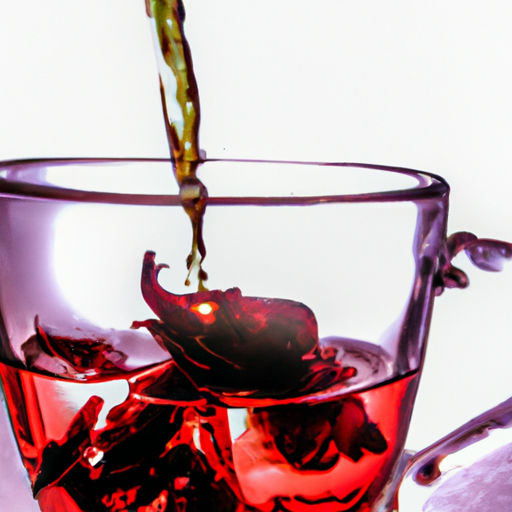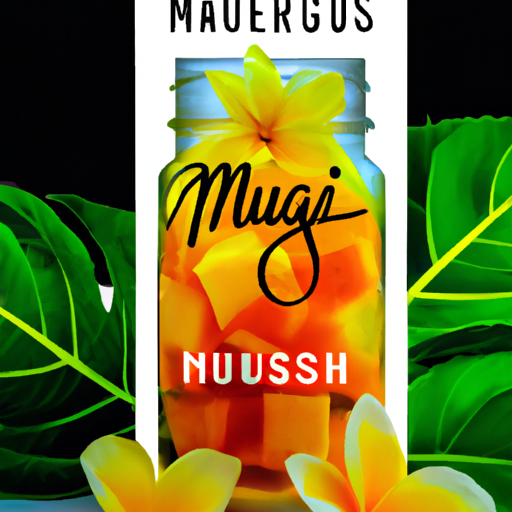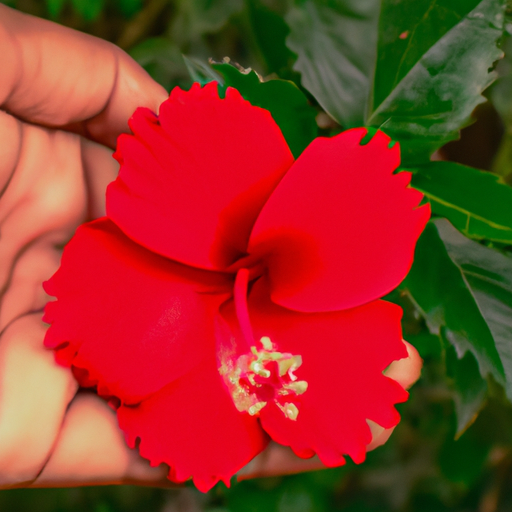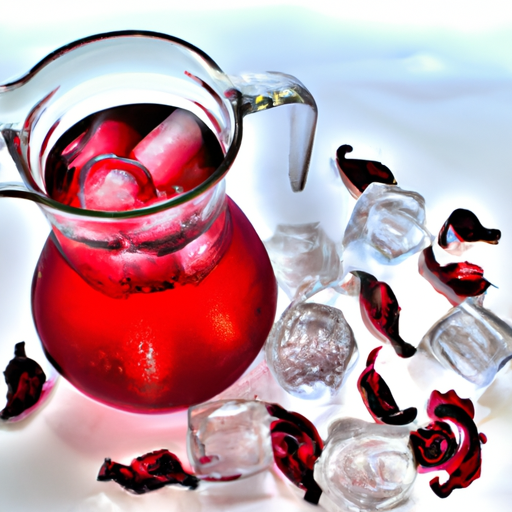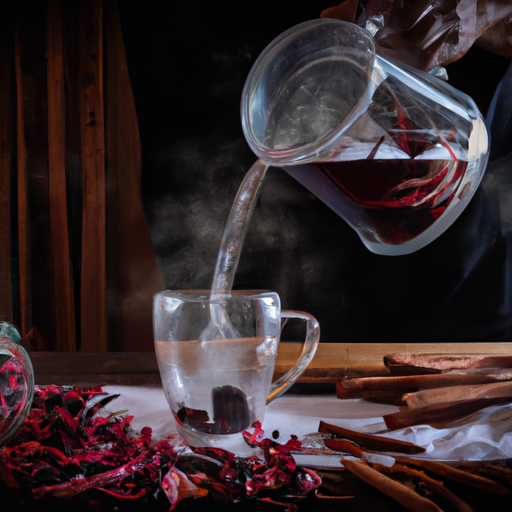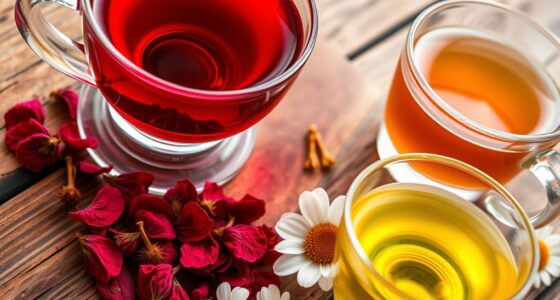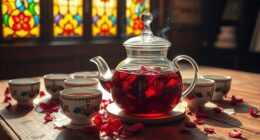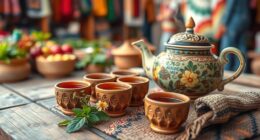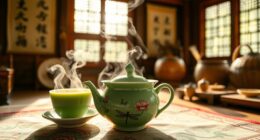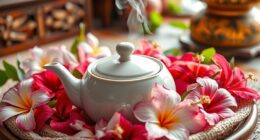I truly love hibiscus tea for its deep and powerful taste that delivers a delightful burst of flavor. This bright red tea comes from the dried petals of the hibiscus flower, giving it a sour, lemony flavor that is both energizing and rejuvenating.
As someone who loves exploring different teas and flavors, I have to say that hibiscus tea holds a special place in my heart.
One of the things I appreciate most about hibiscus tea is its complexity of taste. On one hand, it has a tartness that can almost be described as sour or bitter – but not in an unpleasant way. It’s more like the tang you get from biting into a juicy grapefruit or lemon. At the same time, there are also sweet notes to be found in hibiscus tea, particularly if you add honey or sugar to your brew.
The result is a drink that strikes a perfect balance between acidity and sweetness, making it an ideal choice for all kinds of occasions.
Key Takeaways
- Hibiscus tea has a rich and robust flavor with a tangy, citrusy taste that is both tart and sweet.
- It is a perfect balance between acidity and sweetness, with a unique fruity flavor and vibrant red color.
- The tea has a distinctive floral aroma that adds an extra layer of complexity to its flavor profile, and it can be enjoyed hot or cold.
- Hibiscus tea has numerous traditional and modern uses, from helping to lower blood pressure to serving as a base for cocktails and mocktails, and can be paired with sweeteners like honey or sugar, or fresh herbs like mint or basil.
Overview of Hibiscus Tea
If you’re looking for a tart and refreshing beverage, hibiscus tea is the perfect choice. It has a unique fruity flavor and a vibrant red color. This herbal tea has been around for centuries and has a rich history that dates back to ancient Egypt, where it was used as a medicine. Today, people all over the world enjoy hibiscus tea for its delicious taste and numerous health benefits.
Hibiscus plants are typically grown in tropical and subtropical regions. The flowers are harvested when they are fully matured, and the petals of the flower are then dried and steeped into hot water to create a flavorful tea. The cultivation of hibiscus plants is an important industry in many countries, including Mexico, Egypt, Sudan, Thailand, and Jamaica.
The flavor profile of hibiscus tea is both tangy and sweet, with a slightly sour aftertaste. It’s often compared to cranberry juice or pomegranate juice because of its tartness. Some people also detect notes of citrus or raspberry in the tea’s aroma. Overall, it’s a unique tasting beverage that can be enjoyed hot or cold depending on your preference.
As you can see, hibiscus tea is a truly one-of-a-kind beverage that offers not only great taste but also multiple health benefits!
Flavor Profile of Hibiscus Tea
I absolutely love the tart and tangy taste of hibiscus tea. It’s like a burst of flavor in every sip, making it a perfect choice for those who enjoy bold and refreshing drinks.
When compared to other fruits, hibiscus tea is often described as having a similar taste profile to cranberries or pomegranates, but with its own unique twist that sets it apart from the rest.
Additionally, the floral aroma of hibiscus tea adds an extra layer of complexity to its flavor profile, making it a truly delightful experience for all the senses.
Tart and Tangy Taste
The tart and tangy flavor of hibiscus tea is one of its most distinctive characteristics. As someone who loves bold, refreshing flavors, I find it to be an absolute delight.
The high levels of natural acidity in the hibiscus plant give the tea a mouth-puckering quality that wakes up the taste buds and makes your palate feel alive.
Despite its intense flavor profile, hibiscus tea can still be quite versatile when it comes to pairing suggestions. Some people enjoy sipping it on its own, while others like to mix it with sweeteners like honey or agave nectar to balance out the sourness.
It also pairs well with citrus fruits like lemon and orange, as well as spicy foods like curry or chili peppers. With so many options for pairing and customization, there’s no shortage of ways to enjoy this tangy beverage.
When comparing hibiscus tea’s tartness to other fruits, one might liken it to the sharpness of cranberries or sour cherries. However, unlike these fruits which can often leave a bitter aftertaste on the tongue, hibiscus tea has a clean finish that leaves you feeling refreshed rather than overwhelmed.
Comparison to Other Fruits
Get ready to discover how hibiscus tea stacks up against other fruits in terms of flavor. As someone who has tried almost every fruit out there, I can confidently say that hibiscus tea has a unique taste that sets it apart from the rest. While it may have a tart and tangy flavor like some fruits, its taste profile is more complex than that.
To illustrate this point, let’s do a quick fruit comparison using a table:
| Fruit | Taste |
|---|---|
| Orange | Citrusy, sweet |
| Pineapple | Sweet, tropical |
| Raspberry | Tart, juicy |
| Hibiscus Tea | Tart, floral |
As you can see from the table above, hibiscus tea has a distinct taste compared to other popular fruits. While it shares similarities with raspberry in terms of tartness and juiciness, it also offers a floral note that is not found in any other fruit. This makes for an interesting taste experience that cannot be replicated by any other beverage or food item.
Moving on to the next section about ‘floral aroma’, one cannot talk about hibiscus tea without mentioning its unique scent.
Floral Aroma
Explore the floral aroma of hibiscus tea and let your senses be transported to a garden filled with blooming flowers. The sweet, fruity notes are complemented by a subtle hint of earthiness, creating a complex and nuanced scent that is instantly recognizable.
As you inhale the steam rising from your cup, you’ll notice the delicate balance between these different elements, which come together to create an experience that is both refreshing and invigorating. If you’re looking for ways to enhance your enjoyment of hibiscus tea, there are several pairing suggestions to consider.
This tea pairs well with fresh fruit like berries and citrus fruits, as well as savory dishes like grilled chicken or fish tacos. Additionally, hibiscus tea has been shown to have aromatherapy benefits that can help reduce stress levels and promote relaxation – making it the perfect beverage to enjoy after a long day at work or during a yoga practice.
As we move on to preparation and serving suggestions, it’s important to keep in mind the unique flavor profile of hibiscus tea and how best to bring out its full potential.
Preparation and Serving Suggestions
For a more flavorful cup of hibiscus tea, I recommend trying out various brewing methods. One simple method is to steep the dried hibiscus flowers in boiling water for around 5 minutes. If you prefer a stronger flavor, you can increase the steeping time or add more flowers. Alternatively, you can simmer the flowers on low heat for 15-20 minutes to extract all their essence and obtain a richer flavor.
To complement its tartness, hibiscus tea pairs well with sweet foods such as honey or sugar. However, if you prefer less sweetness in your drink, try adding fresh herbs like mint or basil instead. These herbs not only add an interesting twist but also offer additional health benefits.
In addition to being delicious, hibiscus tea has numerous traditional and modern uses that make it an incredibly versatile beverage. From helping lower blood pressure to serving as a base for cocktails and mocktails, there’s no limit to what this tea can do!
Traditional and Modern Uses
Moving on from preparation and serving suggestions, let’s explore the traditional and modern uses of hibiscus tea. This versatile beverage has been enjoyed for centuries across various cultures, with each region having its unique way of preparing it. Traditional methods involve steeping the dried calyces in hot water, sometimes adding spices like ginger or cinnamon to enhance the flavor. Modern innovations have seen hibiscus tea infused into cocktails, smoothies, and even ice cream.
To give you a better understanding of how hibiscus tea is used around the world, check out this table:
| Region | Traditional Use | Modern Innovation |
|---|---|---|
| Mexico | Agua de Jamaica (sweetened hibiscus tea) served cold with meals | Hibiscus Margaritas |
| Egypt | Karkadeh (hot or cold infusion) consumed during Ramadan fasting period | Hibiscus Iced Tea |
| Thailand | Nam Krajeab Chai (hibiscus iced tea) paired with spicy food to balance flavors | Hibiscus Smoothies |
As you can see from the table above, hibiscus tea has evolved over time to cater to different tastes and preferences. While some people still prefer it as a standalone drink, others enjoy it mixed with other ingredients for a more diverse taste experience. The health benefits associated with this beverage have also contributed significantly to its popularity in recent years.
Whether you prefer your hibiscus tea brewed traditionally or blended innovatively with other ingredients, there is no denying that this beverage has something for everyone. In the next section about ‘varieties and blends,’ we will further explore how different flavors are achieved using various blends of herbs and fruits.
Varieties and Blends
Let’s delve into the different varieties and blends of hibiscus infusions, uncovering how certain ingredients work together to create unique taste experiences.
Hibiscus tea can be enjoyed in a variety of ways, from traditional hot brews to refreshing iced teas. Popular brands like Tazo and Harney & Sons offer their own unique takes on hibiscus tea blends, incorporating other flavors such as lemon or mint for added complexity.
Infusion techniques also play a role in the taste of hibiscus tea. Steeping the dried flowers for a longer period of time will result in a stronger, more tart flavor, while shorter steep times will yield a milder taste with subtle floral notes. Some people also enjoy adding sweeteners like honey or agave syrup to balance out the naturally tangy flavor profile.
Overall, there’s no one "right"way to enjoy hibiscus tea; it all comes down to personal preference. Whether you prefer a classic blend or something more experimental, there are endless possibilities when it comes to tasting this versatile herbal infusion.
Moving forward into the health benefits section, it’s important to note that these different varieties and blends may have varying effects on your overall wellness.
Health Benefits of Hibiscus Tea
After learning about the different varieties and blends of hibiscus tea, I became curious about its health benefits. As someone who’s always looking for natural ways to improve my well-being, I was excited to discover that hibiscus tea has been linked to several positive effects on the body.
One of the most significant benefits of hibiscus tea is its potential impact on weight loss. Studies have shown that compounds found in hibiscus tea can help regulate metabolism and reduce body fat. While it’s not a magic solution for shedding pounds, incorporating hibiscus tea into a healthy diet and exercise routine could provide an extra boost towards achieving weight loss goals.
Another impressive benefit of hibiscus tea is its ability to lower blood pressure. The same compounds that aid in weight loss also contribute to relaxing blood vessels and improving circulation. This means that regularly consuming hibiscus tea may lead to a reduction in hypertension, which is a common risk factor for heart disease.
While there are certainly many reasons to try out hibiscus tea, it’s important to note that like any substance, there are potential side effects and precautions to consider. However, before delving into those details, let’s first explore some additional benefits of this flavorful beverage.
Potential Side Effects and Precautions
It’s important for you to be aware of potential side effects and precautions when consuming hibiscus tea. While it’s generally safe for most people, it can interact with certain medications such as diuretics or blood pressure medication. It’s best to consult with your doctor before adding hibiscus tea to your diet if you’re taking any prescription medications.
In addition, excessive consumption of hibiscus tea may cause dizziness or stomach discomfort. It’s recommended to start with a small amount and gradually increase the dosage over time. You should also avoid drinking large amounts of hibiscus tea during pregnancy as it may stimulate menstruation or even cause miscarriage.
If you have a history of allergic reactions, it’s important to be cautious when trying new foods or drinks, including hibiscus tea. Symptoms can range from mild itching and redness to more severe reactions such as difficulty breathing or anaphylaxis. As always, it’s best to speak with your doctor before trying any new food or drink, especially if you have a known allergy.
When considering where to buy hibiscus tea, there are many options available both online and in stores. Some health food stores carry loose leaf varieties, while others offer pre-packaged teas in bags. It’s important to read labels carefully and choose reputable brands that source their ingredients responsibly.
With these precautions in mind, enjoying a cup of hibiscus tea can be a delicious and healthy addition to your daily routine!
Where to Buy Hibiscus Tea
If you want to enjoy the numerous health benefits of hibiscus tea, you can easily find it at your local health food store or online. Here are three options for purchasing this delicious and healthy tea:
-
Local Health Food Stores: Many natural food stores carry a variety of loose-leaf teas, including hibiscus tea. These stores often have knowledgeable staff who can help you choose the right blend and answer any questions you may have about brewing or steeping methods.
-
Online Options: If you prefer to shop from the comfort of your own home, there are many reputable online retailers that carry high-quality hibiscus tea blends. Look for websites with detailed product descriptions and customer reviews to ensure that you’re getting a good quality product.
-
Specialty Tea Shops: Some cities have specialty tea shops that offer unique blends and infusions, including hibiscus tea. These shops often have a wider selection of teas than health food stores, so they may be worth checking out if you’re looking for something specific.
Now that we’ve covered where to buy hibiscus tea, let’s move on to some delicious DIY recipes that will allow you to create your own custom blends at home!
DIY Hibiscus Tea Recipes
After finding the perfect place to buy hibiscus tea, it’s time to explore the wonderful world of homemade hibiscus tea recipes. Making your own tea is not only fun and rewarding, but it also allows you to customize and experiment with flavor combinations that suit your taste buds.
Hibiscus tea can be enjoyed hot or cold, and there are many ways to infuse it with other herbs and spices for added health benefits. One popular recipe is a simple hibiscus ginger tea that combines the tartness of hibiscus with the spicy warmth of ginger.
To make this tea, simply brew dried hibiscus flowers in boiling water for about 5 minutes, then add fresh sliced ginger and let steep for another 5-10 minutes. The result is a refreshing and invigorating drink that’s perfect for any time of day.
Another great way to enjoy hibiscus tea is by creating herbal infusions that combine different healing herbs and spices. For example, a calming bedtime blend could include chamomile, lavender, and hibiscus flowers steeped together in hot water for a soothing drink before bed.
Or try adding cinnamon sticks or mint leaves to your hibiscus tea for an added kick of flavor. The possibilities are endless when it comes to experimenting with different ingredients in your homemade teas.
Frequently Asked Questions
Can hibiscus tea be consumed hot or cold?
When it comes to consuming hibiscus tea, the answer is simple – it can be enjoyed hot or cold! Personally, I prefer it iced on a hot summer day. There’s something about the refreshing, tangy flavor that just hits the spot.
But if you’re looking for a cozy drink to warm you up in the winter months, hibiscus tea also makes for a delicious and comforting hot beverage. And let’s not forget about its health benefits – hibiscus tea has been shown to lower blood pressure and improve heart health, making it a great addition to any wellness routine.
So whether you’re sipping on a steaming cup of hibiscus tea or enjoying an ice-cold glass, you can feel good knowing that you’re treating your body right.
Is hibiscus tea caffeine-free?
Hibiscus tea is a great alternative to coffee or traditional caffeinated teas, as it’s naturally caffeine-free. This makes it an ideal choice for those who are sensitive to caffeine or looking for a relaxing beverage before bed.
Beyond its caffeine content, hibiscus tea has many benefits, including being high in antioxidants and vitamin C. It also comes in a variety of flavors and blends, from fruity and tart to sweet and floral.
Whether enjoyed hot or cold, hibiscus tea can be a delicious and healthy addition to your daily routine.
What is the shelf life of hibiscus tea?
Okay, so here’s the deal with hibiscus tea and its shelf life. First of all, I gotta say that this stuff is totally worth stocking up on for the long term. It’s not every day you come across a drink that’s both delicious and good for you!
But when it comes to preserving flavor over time, there are a few things to keep in mind. For starters, make sure you store your hibiscus tea in an airtight container away from light and moisture. This will help prevent any oxidation or mold growth that could spoil the taste.
Additionally, try to consume your tea within about 6-12 months of purchasing it for best results. While it may still be safe to drink beyond this point, the flavors may start to fade or become more bitter as time goes on.
So if you want to savor that tangy-sweet taste of hibiscus at its finest, make sure to sip it up sooner rather than later!
Does hibiscus tea have any cultural significance?
As someone who’s grown up with hibiscus tea cultural traditions, I can attest to its importance in ceremonial practices.
In many cultures, including my own, hibiscus tea is a staple beverage during special occasions such as weddings and religious ceremonies. Its vibrant red color symbolizes love, passion, and devotion which makes it an ideal choice for celebrations.
The tart and tangy taste of the tea is also believed to have medicinal properties that aid digestion and boost the immune system.
Beyond its health benefits, the cultural significance of hibiscus tea cannot be overstated as it continues to play an important role in connecting people to their heritage and traditions.
Can hibiscus tea be mixed with other types of tea?
At first, I was skeptical about mixing hibiscus tea with other types of tea. I thought it might dilute the unique flavor and health benefits that hibiscus tea offers. However, after experimenting with different flavor combinations, I have to say that I’m pleasantly surprised by the results.
Combining hibiscus tea with green or black tea adds a subtle depth and complexity to the taste, while also providing an extra boost of antioxidants and other nutrients. Mixing it with mint or ginger can give it a refreshing zing, perfect for hot summer days.
Overall, there are many benefits to mixing hibiscus tea with other types of teas and flavors – you just need to find what works best for you!
Conclusion
Overall, I’ve come to appreciate the unique taste of hibiscus tea. It’s tart and tangy, a refreshing departure from the typical sweetness found in other teas. The drink’s versatility also allows for endless experimentation with different blends and preparation methods.
As I sip on a steaming cup of hibiscus tea, I can’t help but imagine myself lounging on a tropical beach, surrounded by vibrant flowers and lush greenery. The drink’s bright red color and floral aroma transport me to a world of relaxation and exoticism.
Hibiscus tea truly embodies the essence of paradise in every sip.

